| CHAPTER II.
POSTURE IN LABOR. Labor Among Primitive Peoples | ||
4. SEMI-RECUMBENT.
The semi-recumbent positions are by far the most frequent among the ancients, especially among the more civilized people of olden times, and among the savage races of the present day. The same position of the body is assumed by various races in very different ways, there being apparently no resemblance in the method of delivery, whilst it appears, upon more careful study, that the position of the body, the inclination of the trunk and the pelvic axis, together with the relaxed position of the thighs, is almost identical, the same end being accomplished in ways very different, peculiar to each people, and in keeping with their surroundings. Thus, the simplest of the semi-recumbent positions, which is upon a par with the customs of the rudest African races, is sitting upon the ground, upon a stone or rude cushion, with the body inclined backward, leaning against an assistant, a tree, or some other object. A marked progress is achieved, when we find the parturient woman seated in the lap of an assistant reclining against his chest, a position which reaches its greatest perfection in the obstetric chair. As the next step, I regard the dorsal decubitus, a position modified according to the circumstances of the people. In the wilds of Africa, and in the interior of our western country, the patient finds her couch upon the floor, propped up against some staves of wood or a pile of grass, whilst in the lying-in chamber of the civilized people
(a.) Sitting Semi-recumbent on the Ground, upon a Stone, or Stool.
Among our Indians we find that the Otoes, Missouris, Omahas, Iowas, and nearly related tribes assume the sitting posture, the legs widely separated; but as the crisis supervenes, the patient raises herself somewhat by a rope suspended above, thus attaining an inclined, semi-recumbent position.[90] The Wakah squaw assumes a sitting posture, on the floor of the lodge, with nothing but an Indian mat under her. As soon as the labor pains come on her feet are drawn up close to the buttocks, and the legs flexed; this position is maintained until after the birth of the child and the expulsion of the placenta.[91]
The women of the Skokomish Agency, W. T., sit down with a pillow or roll of blankets resting against the perineum; one squaw supports the back, while another receives the child. This position is a slightly recumbent one, the buttocks resting on the pillow or roll of blankets.[92] The Confederated tribes of the Flatheads, Pend d'Oreilles, and Kootenais, follow a similar custom: a small box, or a piece of wood, six or eight inches high, covered with old pieces of blanket or buffalo robes, is the seat upon which the sick woman is placed; her legs are separated and flexed so that the heels almost come in contact with the seat. She is retained in that position by two assistants who hold her by the arms, and sometimes a third one stands behind and presses upon her shoulders, and in this position the child is expelled.[93]
Though apparently uncomfortable and inconvenient, and rare among the American Indians, the Kaffirs universally
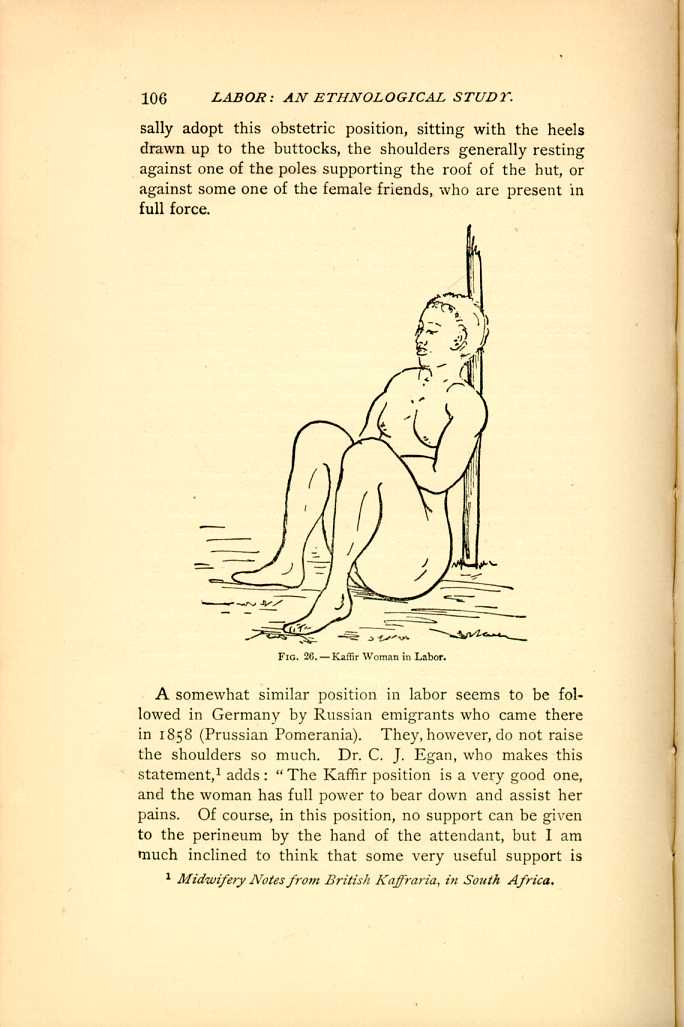
FIG. 26.—Kaffir Woman in Labor.
[Description: Woman sits with her knees up, leaning against a pole. Black and white illustration.]A somewhat similar position in labor seems to be followed in Germany by Russian emigrants who came there in 1858 (Prussian Pomerania). They, however, do not raise the shoulders so much. Dr. C. J. Egan, who makes this statement,[94] adds: "The Kaffir position is a very good one, and the woman has full power to bear down and assist her pains. Of course, in this position, no support can be given to the perineum by the hand of the attendant, but I am much inclined to think that some very useful support is
The Kaffir and the Indian woman sit upon the ground, whilst the somewhat more advanced half-breed, as she is often found in Southern California and New Mexico, seats herself upon a chair, and during the pains, in the same way as her Indian sister, grasps a rope suspended from the ceiling above; but, when tired out in this position, she is often found kneeling upon the ground.[95] A white sister involuntarily testifies to the efficiency of this position, at least under certain conditions,—a primipara who had been in labor for two days and was confined on the third, in a sitting posture, the pains ceasing entirely whenever she assumed a recumbent position; of this the observing attendant, Dr. Von Mansfelde, of Ashland, Neb., assured himself. In order to satisfy himself that it was not the whim of a parturient woman, he placed her on the bed, on her side and back, several times, but the hand placed upon the fundus showed complete relaxation; no sign of contraction. When replaced in the sitting posture the pains readily returned, and were very effective, the woman being delivered within two hours after dilatation of the os.
The Arab woman is seated on two flat stones, or, more properly, her buttocks are slightly supported upon two flat stones, whilst during each pain she partially raises herself by a rope which is suspended from the centre-pole of the tent. Two assistants seize the parturient woman under the shoulders, and she herself, during the pain, raises herself by the rope; they aid this motion, partially suspend her, shaking her well, as the miller does his sack of flour when he empties it, and then, as the pains cease, they drop her back upon the stones. This, at least, was the practice witnessed in several cases in 1858 by Dr. Goguel,[96] in one instance,
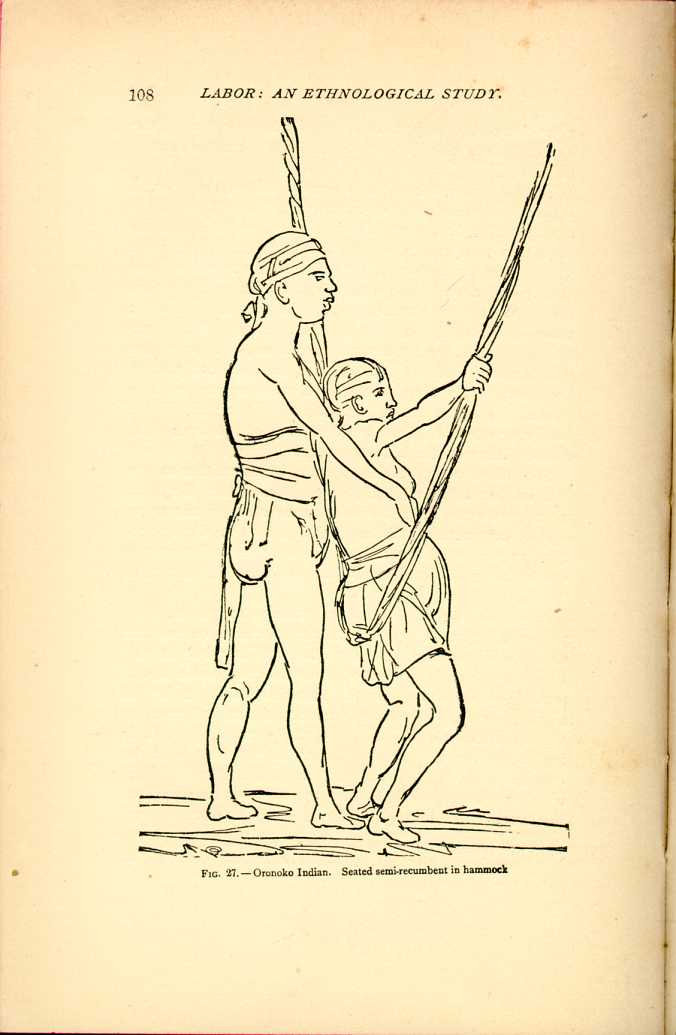
FIG. 27.—Oronoko Indian. Seated semi-recumbent in hammock.
[Description: Pregnant woman sits in a hammock resembling a looped rope, while an assistant stands behind her with hands on her abdomen.]A most admirable position, typically semi-recumbent, was customary in Greece and her provinces 2,200 years ago, as is proven by that interesting group, representing a labor just completed, which was discovered by General di Cesnola during his researches in Cyprus; we, moreover, have the same undeniable evidence that this marble group faithfully represents the obstetric position in Cyprus twenty-two centuries ago as we have of the correctness of the Peruvian posture at the time of the Inkas, as pictured upon the funeral urn. The native Peruvians of the present day are still confined whilst seated upon the husband's lap; and the Cypriote midwife of to-day still places her patient in the semi-recumbent position upon a low stool which she carries about with her.
In response to my inquiries, General di Cesnola kindly furnished me with the following most valuable information. He says: "The group was found among the déris of the temple at Golgoi, in 1871, and is of the best Greek epoch, say 400 B. C. The chair on which the woman is reclining, is Cypriote, and was probably used also in Greece at that period; the modern Cypriote midwives possess similar low chairs, which they carry with them when going to attend a child-birth, and I have myself seen the circumstances as shown in that group, which faithfully represents the parturition
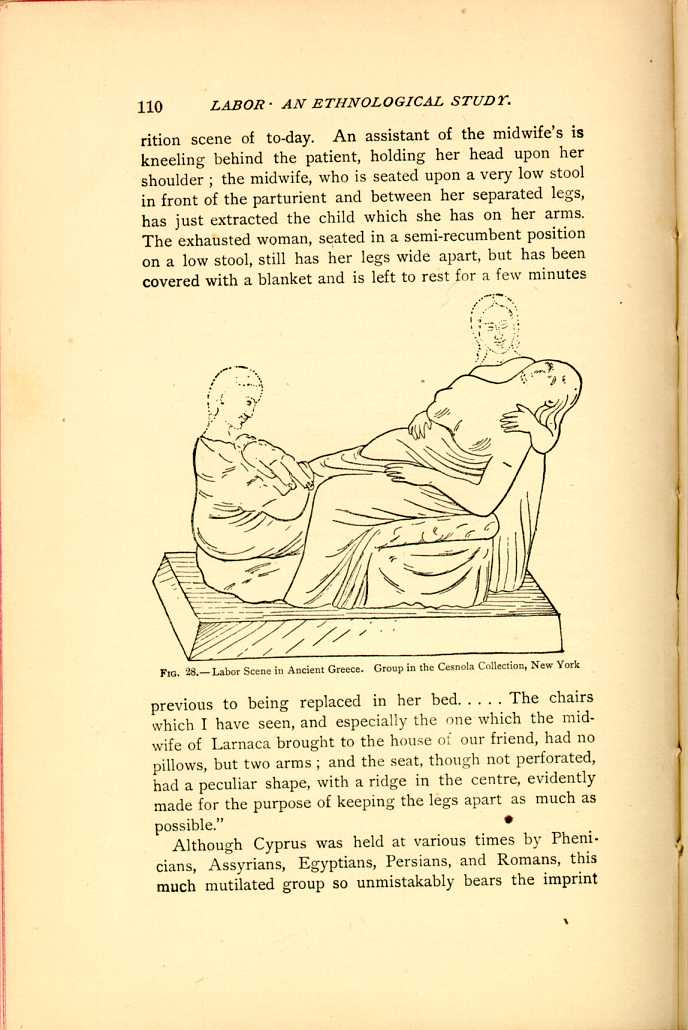
FIG. 28,—Labor Scene in Ancient Greece. Group in the Cesnola Collection, New York
[Description: Woman gives birth, assisted by two ghostly figures.]Although Cyprus was held at various times by Phenicians, Assyrians, Egyptians, Persians, and Romans, this much mutilated group so unmistakably bears the imprint
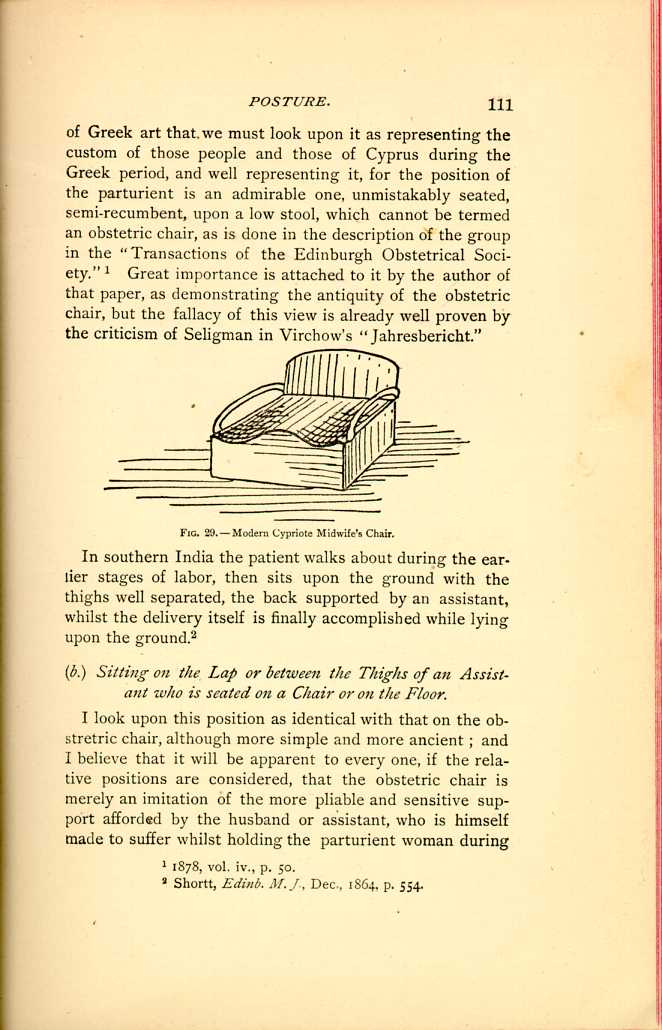
FIG. 29.—Modern Cypriote Midwife's Chair.
[Description: Low midwife's chair, without legs and with arm rails. Black and white illustration.]In southern India the patient walks about during the earlier stages of labor, then sits upon the ground with the thighs well separated, the back supported by an assistant, whilst the delivery itself is finally accomplished while lying upon the ground.[99]
(b.) Sitting on the Lap or between the Thighs of an Assistant who is seated on a Chair or on the Floor.
I look upon this position as identical with that on the obstretric chair, although more simple and more ancient; and I believe that it will be apparent to every one, if the relative positions are considered, that the obstetric chair is merely an imitation of the more pliable and sensitive support afforded by the husband or assistant, who is himself made to suffer whilst holding the parturient woman during
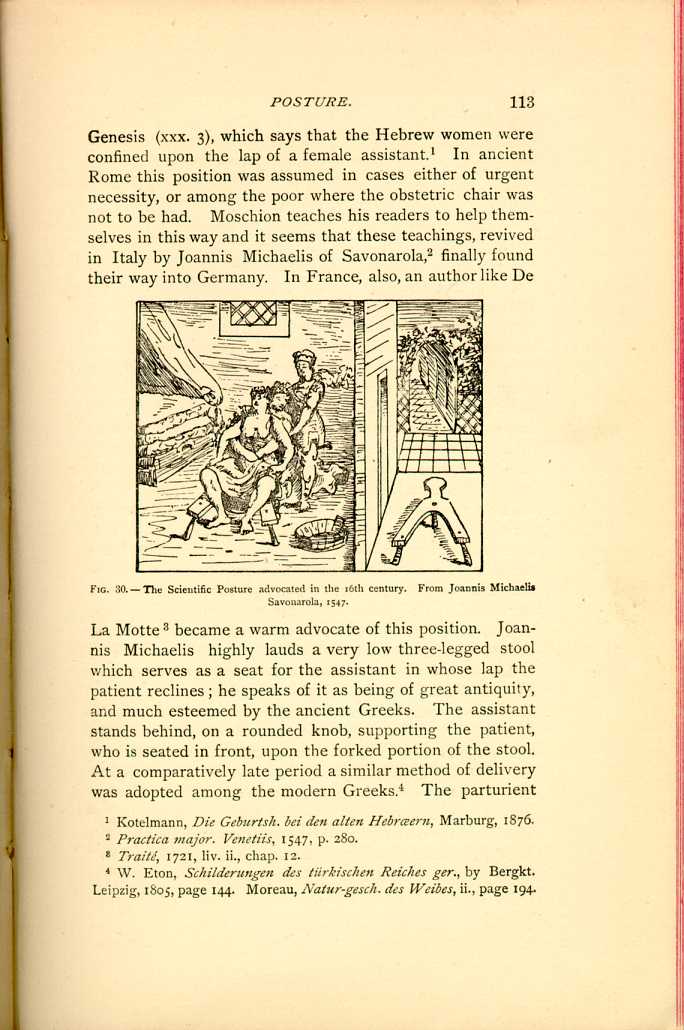
FIG. 30.—The Scientific Posture advocated in the 16th century. From Joannis Michaelis Savonarola, 1547.
[Description: Woman seated on low y-shaped stool, with assistants behind her. Black and white illustration.]We have seen how the modern Peruvians still follow the ways of the Incas, and so the descendants of these Germans, Welsh, or Scotch have not forgotten the habits of their ancestors, although they have crossed the seas and have mingled with a more enlightened civilization. It may surprise some of our city practitioners of to-day, who see little of the country population, and especially those who have not practiced in rural districts years ago, that in our
A graphic description of obstetric practice in the rural
districts of Ohio is given me by Dr. E. B. Stevens of Lebanon,
Ohio, and embodies all that has been written me from
other States. To quote his own words: "When I commenced
to practice, a good many years ago, the almost universal
habit of confinement throughout the regions of southern
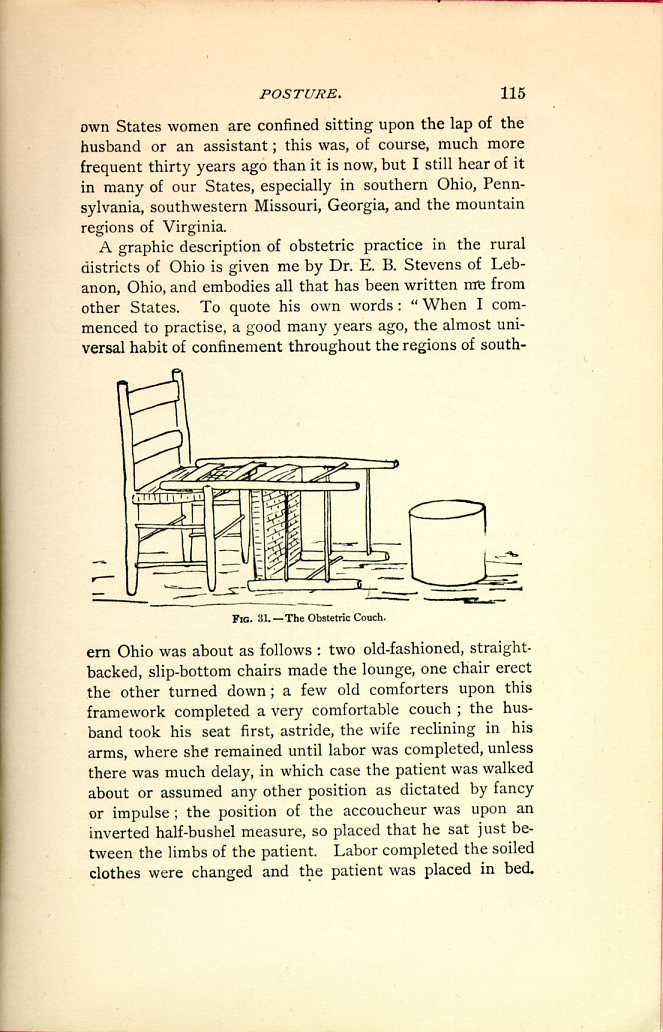
FIG. 31.—The Obstetric Couch.
[Description: One straight-backed chair upright, with a second overturned so
that its back rails rest upon the seat of the first chair. Black and
white illustration.]
I have been told of this position in so many different
parts of this country that it would be superfluous to refer
to individual statements; it is found in Pennsylvania, and
among Pennsylvania emigrants in southwestern Missouri,
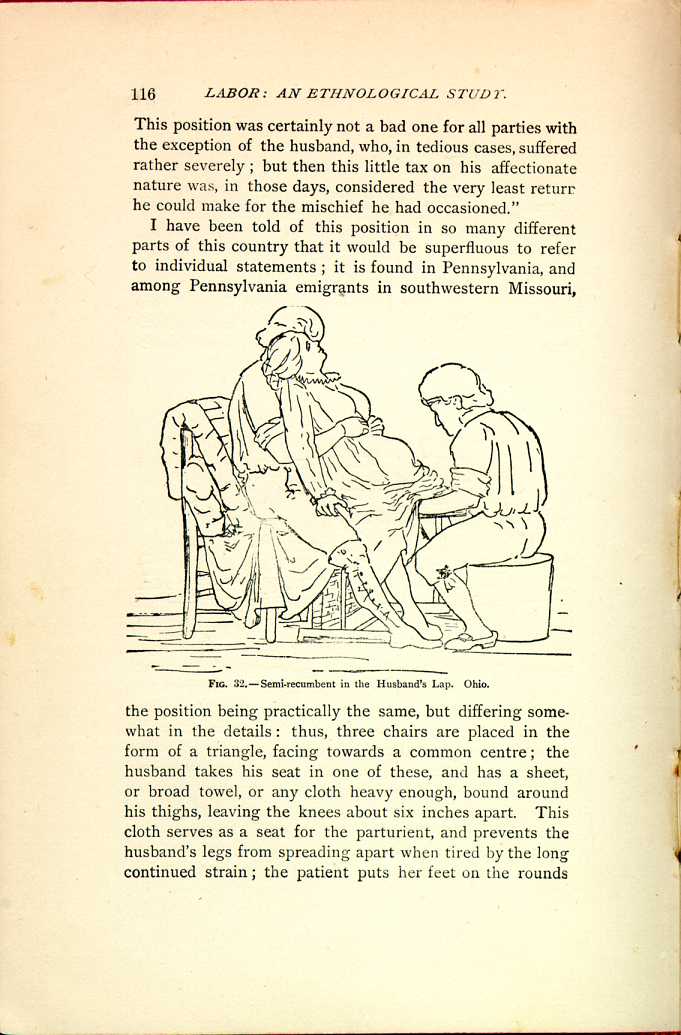
FIG. 32.—Semi-recumbent in the Husband's Lap. Ohio.
[Description: Wife reclines in husband's lap, while another person assists in
the delivery. Black and white illustration.]
A professional friend in this State, who, like many other
practitioners, tells me that the first patient he ever delivered
was confined in this position, says that since then he
has delivered quite a number of women in this way, and
thinks it a great help in cases where the head constantly
retreats after the pain ceases; in the rural districts of
Georgia both negro and white women, now and then, still
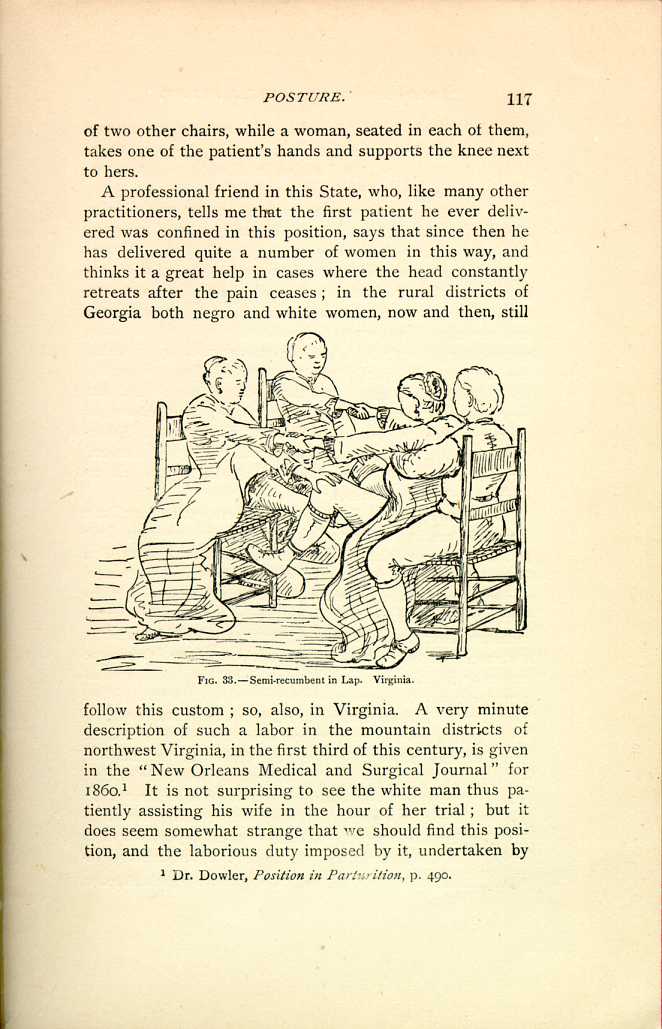
FIG. 33.—Semi-recumbent in Lap. Virginia.
[Description: Pregnant woman sits in husband's lap while two friends sit
facing them in straight-backed chairs, each supporting one of her knees
and holding one of her hands. Black and white illustration.]
The Indians, and lower class of Mexicans in the vicinity of San Luis Potosi, are confined either in a kneeling position partially suspended, or sitting upon the floor. If confined in the latter position, the accouchée sits on a sheepskin on the floor, between the legs of one of the assistants, the tenedora, or holder, who is seated on a little cushion, and serves as a support to the patient, her thighs pressing against the patient's hips, and her arms encircling her waist, the hands clasped just above the fundus of the distended uterus, so that she can follow the child in its descent, and exert a gradual but strong compression; the partera, of course, takes her position in front of the patient. Sometimes, in a tedious labor, this awkward posture is retained for one or two days, with not a little suffering to the tenedora as well as the patient.[108]
The custom of the Sandwich Islanders varies very little from this, and it is a matter of some interest to note their habits, as these islands, two thousand miles west of San Francisco, were entirely unknown one hundred years ago, and even fifty years ago were perfectly barbarous; it is important to us, more especially as they still retain, in a great measure, their crude ideas and practices. Very interesting statements as to the obstetric practices in these islands are made by Dr. Charles H. Wetmore,[109] who has had a professional experience of twenty-two years upon Hawaii. When the labor is fairly commencing, the patient assumes a sitting posture upon a hard pillow or stone, her husband, or some intimate male or female friend, kneeling behind her, whose duty it is to clasp her above the abdomen in such a way that he can press down with considerable force upon the uterus and its contents, never relaxing this grasp to allow the fetus to recede. The accoucheur's position is in front; she has little to do but to receive the child. Precisely
I have repeatedly had occasion to refer to the nomadic
and barbarous tribes of Asia, as they have so successfully
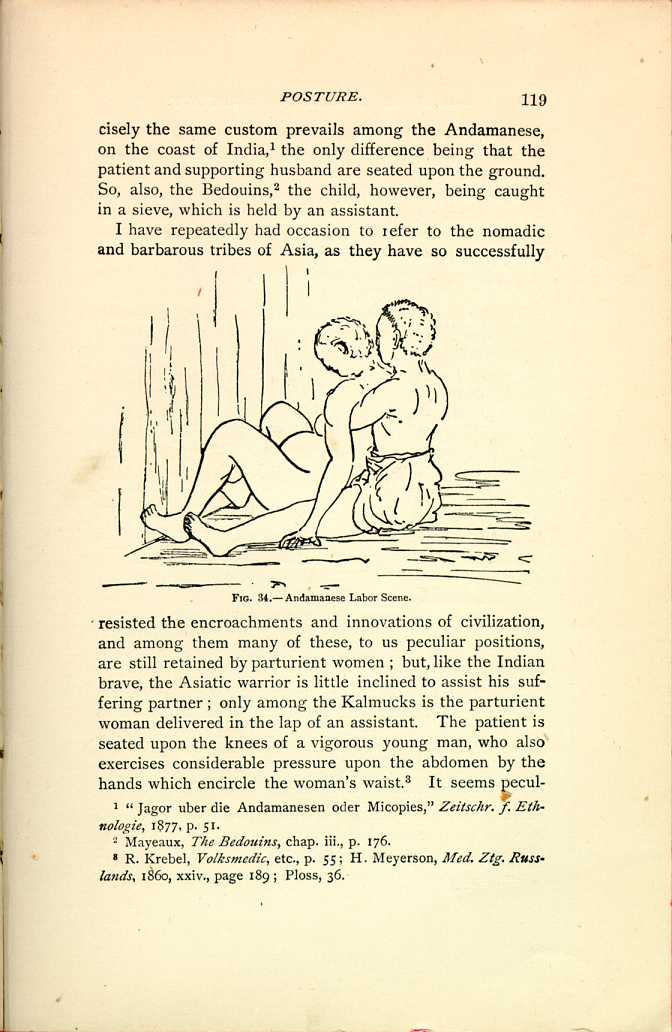
FIG. 34.—Andamanese Labor Scene.
[Description: Pregnant woman sits on floor, facing wall, while assistant sits
behind her with legs spread, supporting her. Black and white
illustration.]
(c). The Obstetric Chair.
The positions we have so far considered have been almost
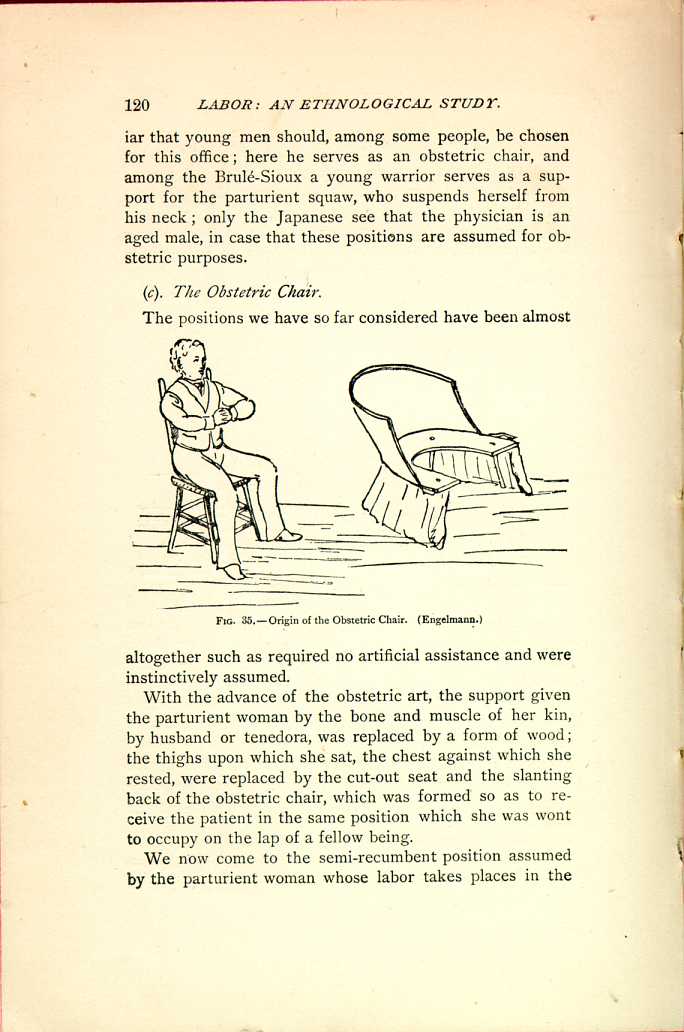
FIG. 35.—Origin of the Obstetric Chair. (Engelmann.)
[Description: Man sitting in chair with legs spread; obstetric chair with
U-shaped seat, providing similar support for back and legs. Black and
white illustration.]
With the advance of the obstetric art, the support given the parturient woman by the bone and muscle of her kin, by husband or tenedora, was replaced by a form of wood; the thighs upon which she sat, the chest against which she rested, were replaced by the cut-out seat and the slanting back of the obstetric chair, which was formed so as to receive the patient in the same position which she was wont to occupy on the lap of a fellow being.
We now come to the semi-recumbent position assumed by the parturient woman whose labor takes places in the
The obstetric chair marks a decided era in the history of
the art; but I must consider that period as a whole, and in
speaking of the chair I have reference to its more characteristic
features, to those points which are common to all obstetric
chairs, as it is not my purpose here to describe the
various obstetric chairs which were in use at different times,
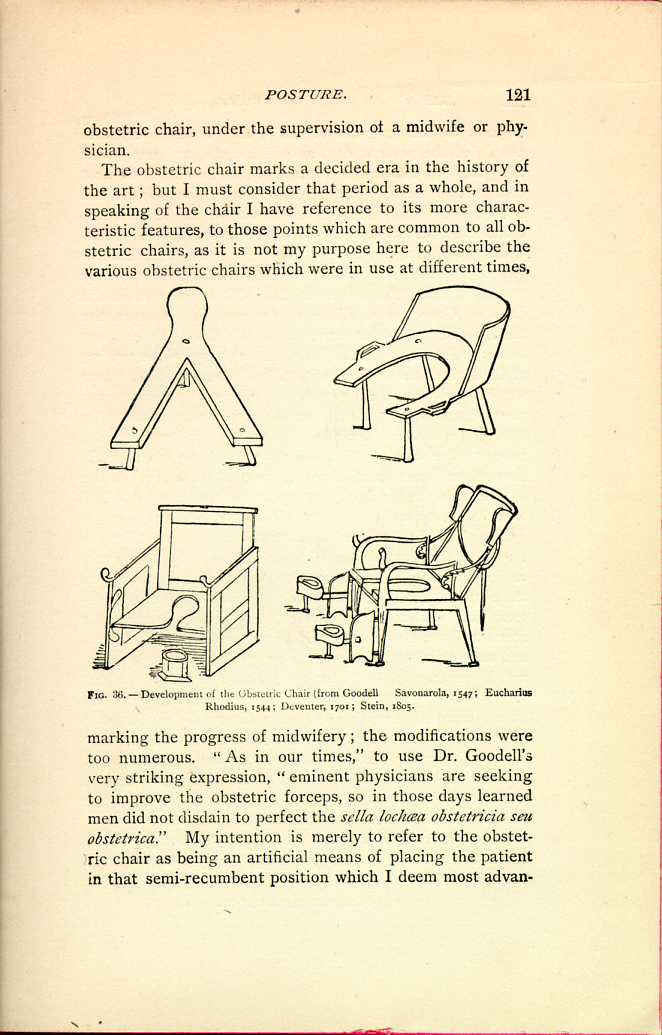
FIG. 36.—Development of the Obstetric Chair
(from Goodell Savonarola, 1547; Eucharius
Rhodius, 1544; Deventer, 1701; Stein, 1805.
[Description: Four different varieties of obstetric chairs are depicted.
Black and white illustration.]
The chair is mentioned by Albertus Magnus in the thirteenth century, and in the German translation of this work, under date of 1589, an illustration is given which resembles the obstetric chair of Soranus and Moschion. In the seventeenth and earlier part of the eighteenth century the chair seems to have flourished in Germany, and also in England, and numerous modifications were introduced. Its supremacy, however, was not of long duration, and it soon yielded to the modern recumbent position, and was only retained by the more conservative people in the rural districts, who follow but slowly in the wake of any advance. Smellie[113] says: "In remote parts of England the patient sat upon a stool made in the form of a semicircle.'' This, of course, was during the time of the decline of the chair, when the dorsal and lateral decubitus had become popular.
In the seventeenth century it was to be found in the centres of medical learning, and had not yet been forced back into the rural wilds.
As a matter of curiosity. I will cite the title of a work published in 1637, in which it was warmly advocated, and I will add a brief description of the chair, in the quaint language of the book, kindly furnished me by Dr. Wise, of the Surgeon-general's Library, and it will answer for this as well as all other chairs, and will serve to show the importance attached to its various features.
"The Expert Midwife: or, an Excellent and most necessary Treatise of the Generation and Birth of Man. Wherein is contained many very Notable and Necessary Particulars requisite to be knowne and practiced: with Divers Apt and Useful Figures appropriated to this Worke. Also the Causes, signes, and Various Cures, of the most Principall Maladies and Infirmities incident to Women. Six Books compiled in Latine by the Industry of James Rueff, a Learned and Expert Chirurgion: and now translated into English for the Generall Good and Benefit of this Nation.''
"Let the stoole be made compassewise, under-propped with foure feet, the stay of it behind bending backward, hollow in the midst, covered with a blacke cloth underneath, hanging downe to the ground, by that meanes that the labouring woman may be covered, and other women sometimes apply their hands in any place, if necessity require. Let the stoole be furnished and covered with many cloths and clouts at the back and other parts, that the labouring woman receive no hurt, or the infant anywhere, strongly kicking and striving because of the paines, stirrings and motions of the mother. And after the labouring woman shall be set in her chaire about to be delivered, the midwife shall place one woman behind her back which may gently hold the labouring woman, taking her by both the armes, and if need be, the pains waxing grievous, and the woman labouring, may stroke and presse downe the wombe, and may somewhat drive and depress the infant downward. But let her place other two by her sides, which may both, with good words, encourage and comfort the labouring woman, and also may be ready to helpe and put to their hand at any time. This being done, let the midwife herselfe sit
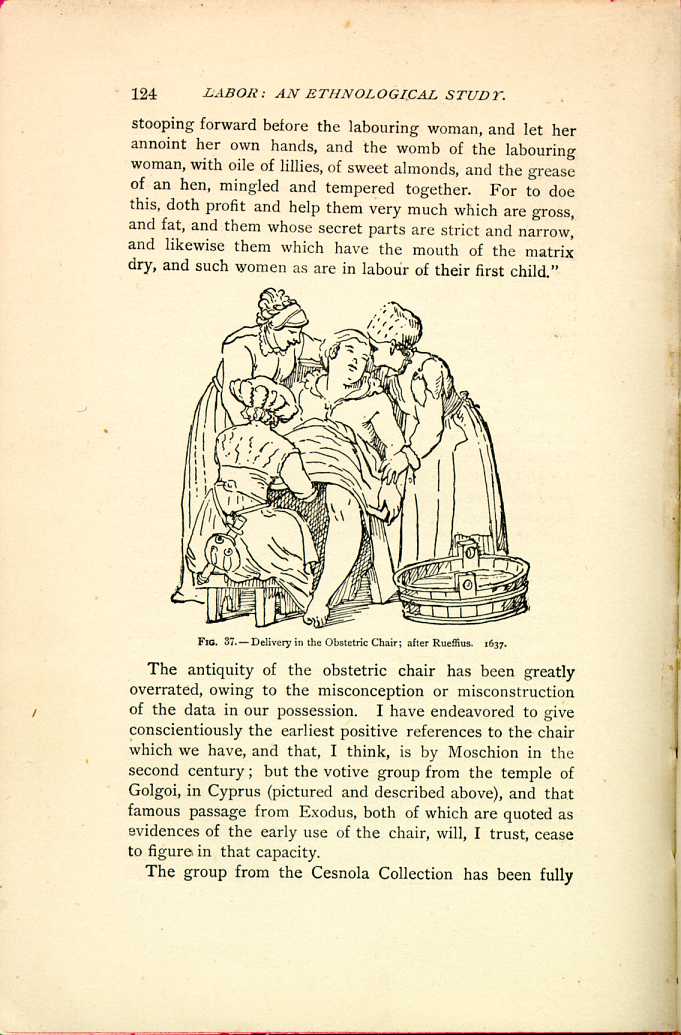
FIG. 37.—Delivery in the Obstetric Chair; after Ruegius. 1637.
[Description: Pregnant woman reclines in an obstetric chair, while a midwife and two friends attend her. Black and white illustration.]The antiquity of the obstetric chair has been greatly overrated, owing to the misconception or misconstruction of the data in our possession. I have endeavored to give conscientiously the earliest positive references to the chair which we have, and that, I think, is by Moschion in the second century; but the votive group from the temple of Golgoi, in Cyprus (pictured and described above), and that famous passage from Exodus, both of which are quoted as evidences of the early use of the chair, will, I trust, cease to figure in that capacity.
The group from the Cesnola Collection has been fully
I have already called attention to the fact that those nations
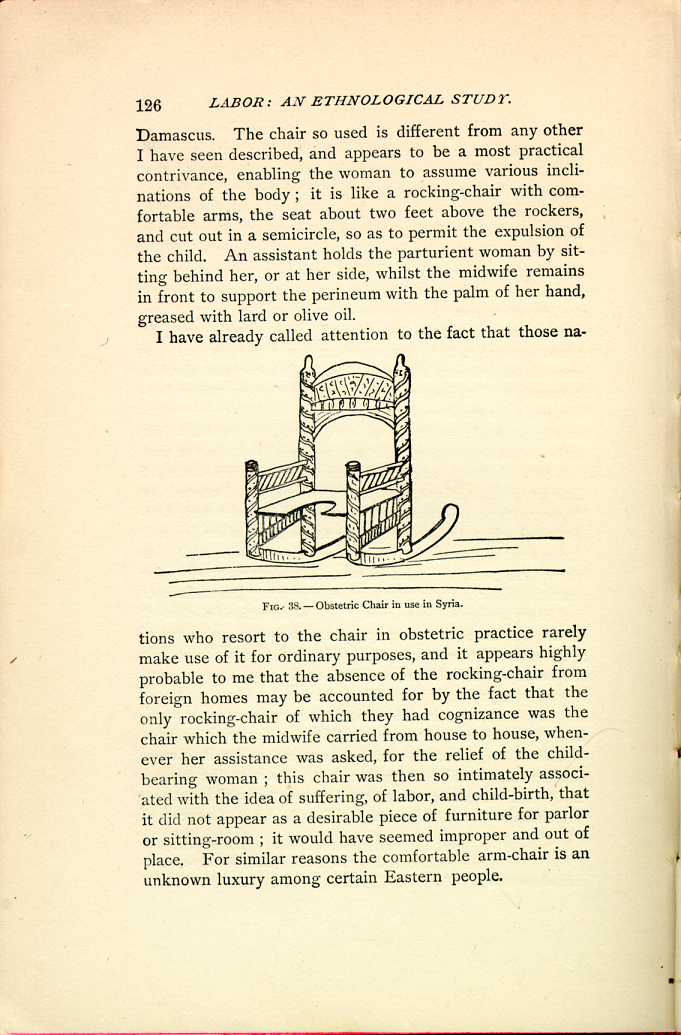
FIG. 38.—Obstetric Chair in use in Syria.
[Description: Obstetric chair designed like a rocking chair, with U-shaped
seat. Black and white illustration.]
It is only within late years that the American rocking-chair has found its way across the ocean, and the increased facilities for intercourse, and the spread of a leveling civilization, will soon do away with these remnants of former times which still linger here and there. Amongst the modern Egyptians, the midwife makes use of a chair, "Kursee El-Wiladeh,'' which is covered with a shawl, or an embroidered napkin, and some flowers of the henna tree, or some roses, are tied with an embroidered handkerchief to each of the upper corners of the back; thus ornamented, the chair is conveyed before the midwife to the house. In the houses of the rich, the parturient is placed on a bed after delivery, and usually remains there from three to six days, whilst the poor women resume their ordinary occupation in a day or two.[116] I will add that Lane, like almost every other author, refers to that passage, Exodus i. 16, intending to compare the custom of using the chair among the Egyptians with that of the ancient Hebrews. In Palestine, the obstetric chair is still an honored institution, but much simplified in form, being sometimes nothing more than an old-fashioned arm-chair.
(d.) Semi-recumbent Position, Strictly Speaking.
Although I have grouped as semi-recumbent all the positions last spoken of, I will, in this subdivision, confine the use of the expression more closely, and will class as semi-recumbent, strictly speaking, only those positions in which the patient assumes the dorsal decubitus with the head and shoulders raised, the axis of the body inclined at an angle of about forty-five degrees.
Like many other of these curious positions, this one is found in our own States, but seems to have come to us from the French settlers in the north. In Vermont, some thirty years ago, a semi-recumbent position was customary, which may either be looked upon as a rude imitation of the obstetric chair, or as a semi-recumbent position, strictly
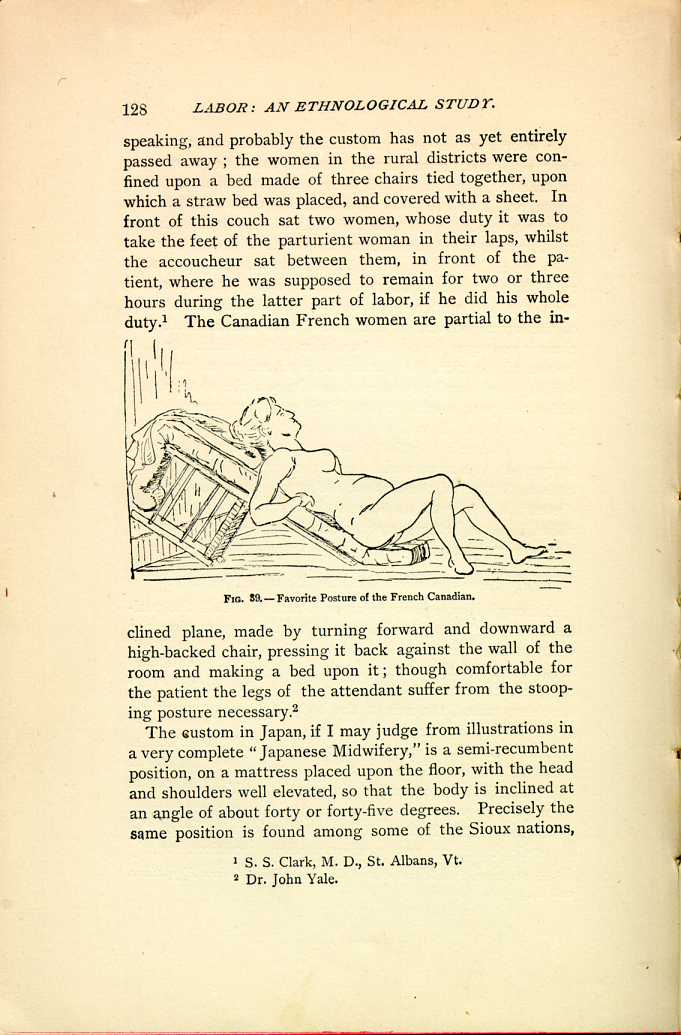
FIG. 59.—Favorite Posture of the French Canadian.
[Description: Pregnant woman reclines on an inclined surface created by propping an overturned chair against the wall and covering it with bedding.]The custom in Japan, if I may judge from illustrations in a very complete "Japanese Midwifery,'' is a semi-recumbent position, on a mattress placed upon the floor, with the head and shoulders well elevated, so that the body is inclined at an angle of about forty or forty-five degrees. Precisely the same position is found among some of the Sioux nations,
The Ute, Comanche, Apache, Navajoe, and Nez-Percés
woman is also confined in the semi-recumbent dorsal position,
the head and shoulders of the patient being frequently
supported in the lap of an attendant, while the patient has
access to a rope or brace placed within
reach.[119]
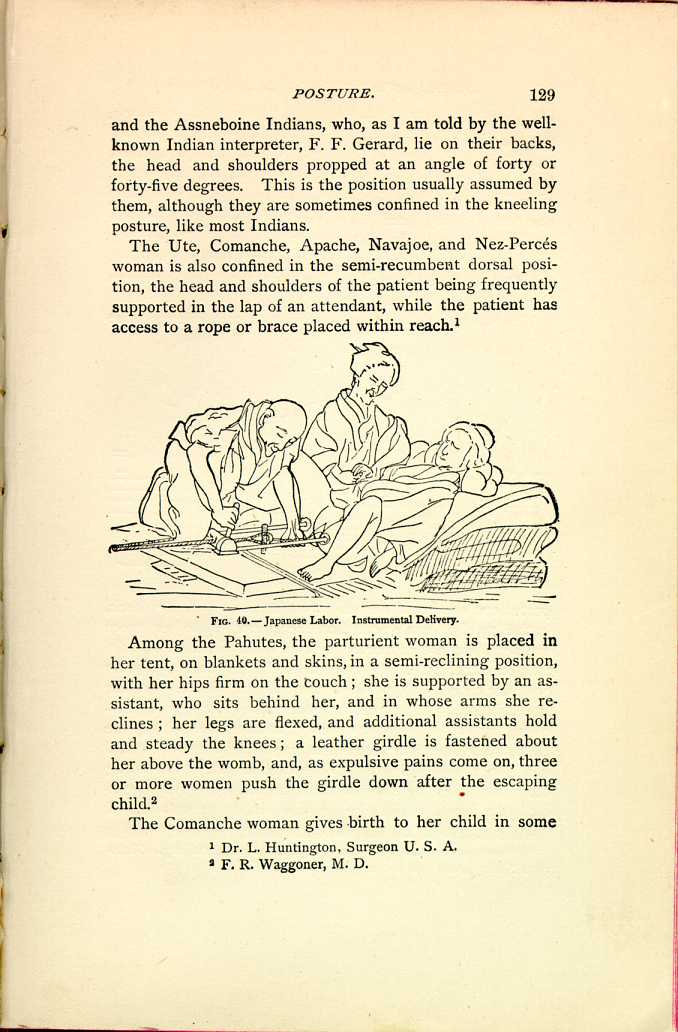
FIG. 40.—Japanese Labor. Instrumental Delivery.
[Description: Woman reclines on floor, with upper body elevated by bedding.
One person works with instruments designed to assist delivery while
another person sits nearby. Black and white illustration.]
Among the Pahutes, the parturient woman is placed in her tent, on blankets and skins, in a semi-reclining position, with her hips firm on the couch; she is supported by an assistant, who sits behind her, and in whose arms she reclines; her legs are flexed, and additional assistants hold and steady the knees; a leather girdle is fastened about her above the womb, and, as expulsive pains come on, three or more women push the girdle down after the escaping child.[120]
The Comanche woman gives birth to her child in some
The Hindoos seem to find the position convenient, as the
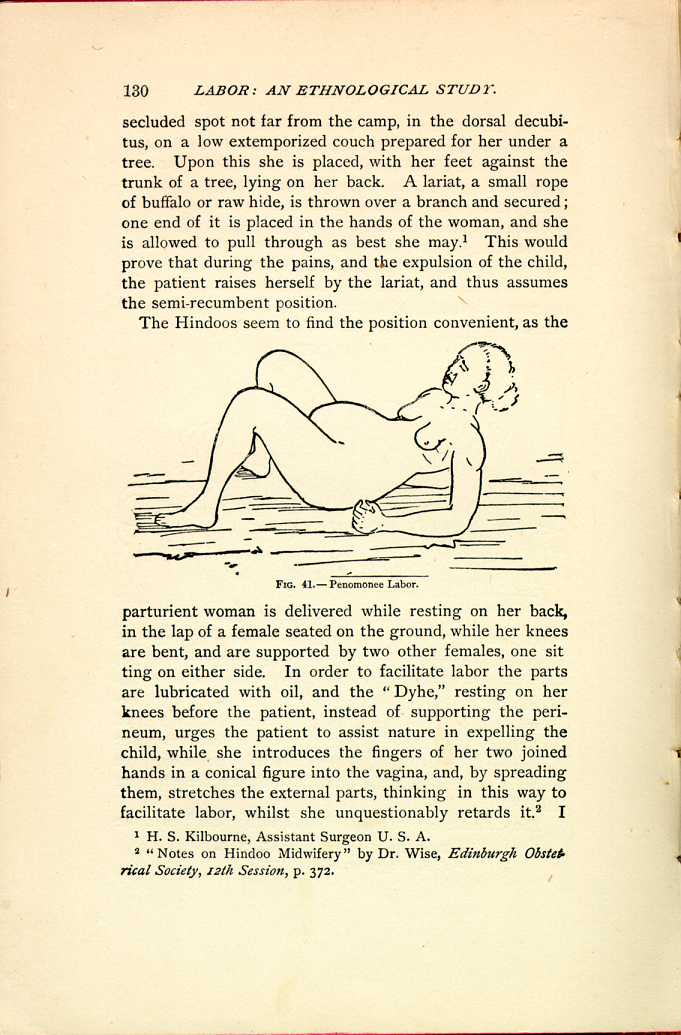
FIG. 41.—Penomonee Labor.
[Description: Woman reclines on floor, her upper body propped up on her
elbows, her knees bent and legs spread.
Black and white illustration.]
The dorsal decubitus, with the body at an angle of forty
or forty-five degrees, was common among the Romans.
Moschion describes it. Celsius[123]
and Paul of Ægina[124]
recommend
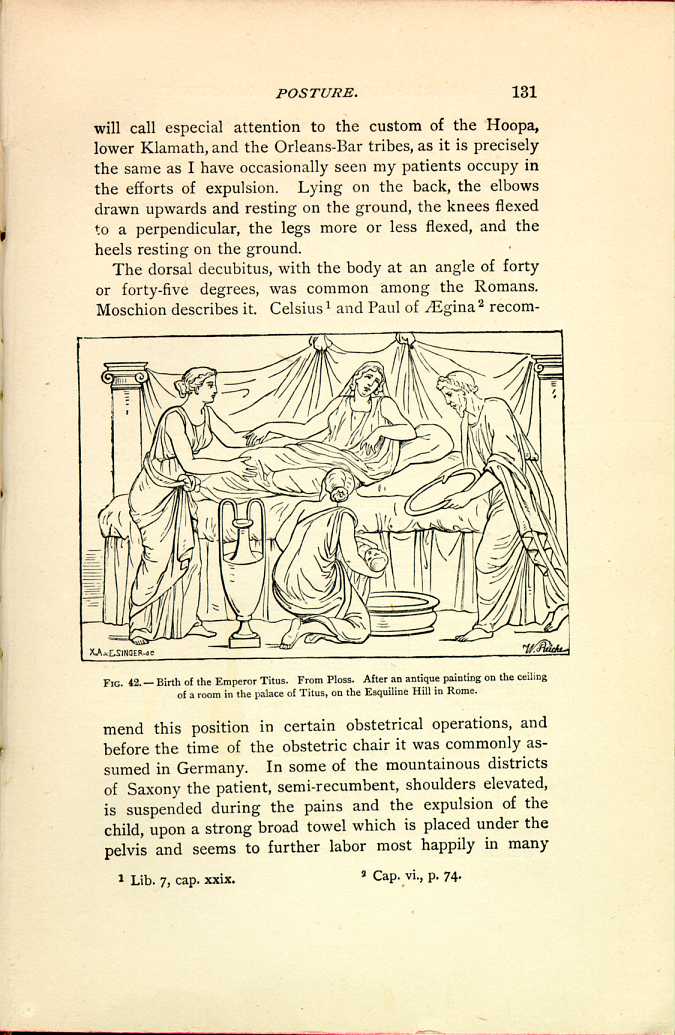
FIG. 42.—Birth of the Emperor Titus.
From Ploss. After an antique painting on the
ceiling of a room in the palace of Titus,
on the Esquiline Hill in Rome.
[Description: Woman reclines in bed as three other persons attend her, one
kneeling beside the bed with the newborn baby.]
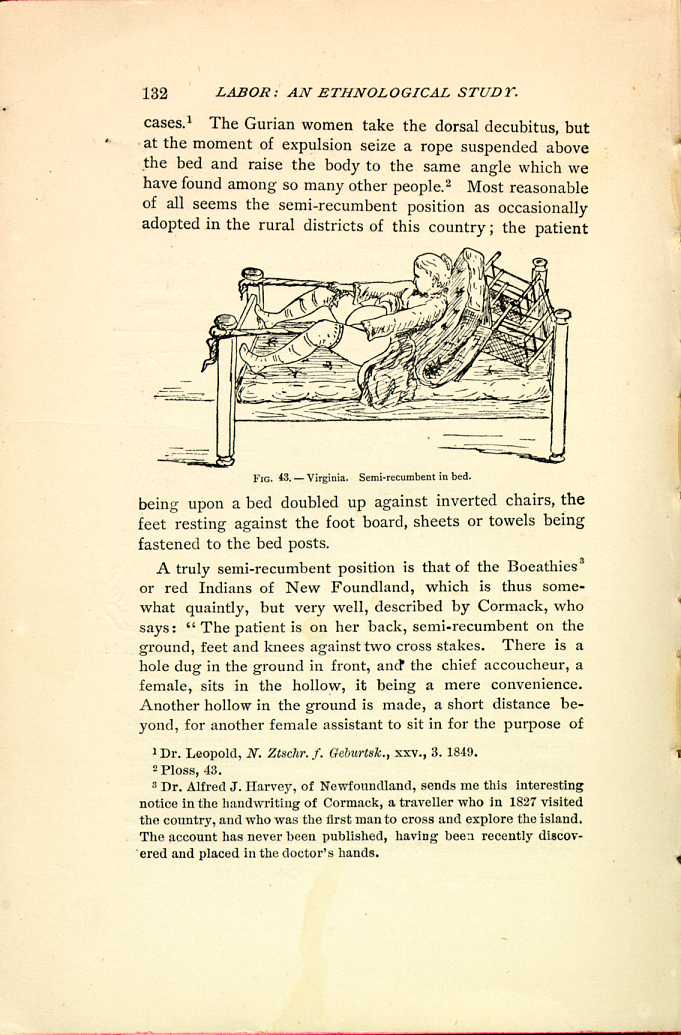
FIG. 43.—Virginia. Semi-recumbent in bed.
[Description: Woman reclines in bed, her upper body propped up by an overturned chair covered with bedding. In each hand, she holds a rope tied to a bedpost at the foot of the bed. Black and white illustration.]A truly semi-recumbent position is that of the Boeathies[127] or red Indians of New Foundland, which is thus somewhat quaintly, but very well, described by Cormack, who says: "The patient is on her back, semi-recumbent on the ground, feet and knees against two cross stakes. There is a hole dug in the ground in front, and the chief accoucheur, a female, sits in the hollow, it being a mere convenience. Another hollow in the ground is made, a short distance beyond, for another female assistant to sit in for the purpose of
Among the Turks, also, the semi-recumbent position prevails, but more erect, seated on ground, stool or chair.[128] Their customs are extremely interesting, as in many of the interior provinces they still cling to their primitive ways.
During the fifth or sixth month of pregnancy the abdomen is compressed by a firm bandage, and this pressure is kept up until full term to prevent the child from growing too large. Abortion is frequent, and is produced by breaking the membranes and allowing the water to escape. Delivery is always accomplished on the lap of an assistant, or seated in a semi-recumbent position on a bed or low stool, or even on the ground, leaning against the stump of a tree or the wall of a house, or some other convenient point. Thus we may say that it is always a sitting posture, either upon the lap of an assistant, upon the ground, or upon the obstetric chair.
Until recently, and even now in distant villages, it is still the custom for the midwife to carry with her the obstetric chair. This, according to my informant, is of a peculiar kind; a large, wooden seat, back chair with a circular opening cut into the front part of the seat, in this differing from all known forms of the obstetric chair, which consist of a mere semi-circular excavation in the seat, this, however, being a complete circle. This carrying about of the chair is the same custom which we have referred to in Syria and other Eastern countries, although the shape of the chair is different. In difficult labor the patient is placed upon a blanket held by four or six persons, and upon this she is rolled about, not tossed up and down as we have seen it customary in other countries.
During the earlier stages the patient lies at will, usually on her back, on a mattress placed on the ground; as labor advances, and the pains increase, one of the stronger of the women present takes the parturient on her lap, compresses the abdomen by her encircling arms, and urges the sufferer to bear down with all her weight. Various other methods are resorted to for the purpose of increasing the pains: thus the bent knees of the patient are constantly and severely jarred, or cold water is forcibly thrown upon the abdomen.
Their midwives are very fond of endeavoring to hasten labor by prematurely rupturing the membranes, cutting them with a sharp piece of salt—often cutting into the scalp as well.
The root of the Alizari (rubia tinctoria) is considered as an emenagogue by the nomadic Turucks, and during childbed the same remedy is resorted to to call forth the lochia when once checked.
In former times bleeding during pregnancy was resorted to with a view of preventing convulsions of the new-born, but is now pretty well given up.
| CHAPTER II.
POSTURE IN LABOR. Labor Among Primitive Peoples | ||